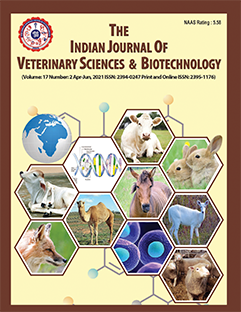Successful Management of Extra Genital Transmissible Venereal Tumor in a Dog
DOI:
https://doi.org/10.48165/ijvsbt.21.4.35Keywords:
canine, transmiss, venereal, tumorAbstract
The canine transmissible venereal tumor (CTVT), also referred to as infectious sarcoma, venereal granuloma, transmissible lymphosarcoma, or sticker tumor, is a contagious neoplasm of unknown origin. It is sexually transmitted and naturally occurs only in dogs, primarily targeting the external genitalia of both male and female animals (Mukaratirwa and Gruys, 2003). Based on the location of the mass, the tumor is categorized into two types: genital TVT and extragenital TVT. The tumor commonly appears as ulcerated masses on the penis, prepuce, or vulva, which tend to bleed easily. Additionally, it may occur in other locations, such as the nasal cavity, oral cavity, eyes, and subcutaneous areas of the skin. Transmission among dogs and other canids can occur through coitus, licking, biting, or sniffing the affected areas (Das and Das, 2000; Rugmini et al., 2025). The neoplasia has a global distribution but is more prevalent in tropical and subtropical regions (Ferreira et al., 2000), particularly in countries with significant populations of stray dogs (Papazoglou et al., 2001). Asodiya et al. (2024), analysed 562 canine neoplasms recorded over 2017 to 2021 at Teaching Veterinary Clinical Complex, Anand (Gujarat, India), and recorded CTVT in 68 (12.09%) cases.
Downloads
References
1. Asodiya, F.A., Hadiya, K.K., Patel, A.C., Parmar, J.J., Mahla, J.K., & Parikh, P.V. (2024). A retrospective study on incidence of neoplasms in canine population around Anand, Gujarat. The Indian Journal of Veterinary Sciences & Biotechnology, 20(1), 74–78.
2. Das, U., & Das, A.K. (2000). Review of canine transmissible venereal sarcoma. Veterinary Research Communications, 24(8), 545–556.
3. Do Amaral, A.S., Bassani-Silva, S., Ferreira, I., da Fonseca, L.S., de Andrade, F.H.E., Gaspar, L.F.J., & Rocha, N.S. (2007). Cytomorphological characterization of transmissible canine venereal tumor. Revista Portuguesa de Ciências Veterinárias, 103(8), 253–260.
4. Ferreira, A.J.A., Jaggy, A., Varejäo, A.P., Ferreira, M.L.P., Correia, J.M.J., Mullas, J.M., & Prada, J. (2000). Brain and ocular metastases from a transmissible venereal tumour in a dog. Journal of Small Animal Practice, 41(4), 165–168.
5. Kumar, V., Hemalatha, S., Balachandran, C., & Jayaprakash, R. (2014). An unusual case of primary subcutaneous venereal granuloma (TVT) in a German shepherd and its therapeutic management. Indian Veterinary Journal, 91(6), 84–86.
6. Mukaratirwa, S., & Gruys, E. (2003). Canine transmissible venereal tumour: Cytogenetic origin, immunophenotype, and immunobiology. A review. Veterinary Quarterly, 25(3), 101–111.
7. Palanisamy, S., Devaraju, S., Margandan, V., & Mahalingam, G. (2023). Rare complex fistulations of frontal sinus, occulo-nasal and oro-nasal passages due to nasal form of canine transmissible venereal tumour. Veterinary Record Case Reports, 11(2), e599.
8. Papazoglou, L.G., Koutinas, A.F., Plevraki, A.G., & Tontis, D. (2001). Primary intranasal transmissible venereal tumour in the dog: A retrospective study of six spontaneous cases. Journal of Veterinary Medicine Series A, 48(7), 391–400.
9. Parikh, N.P., Panchal, M.T., Parmar, J.J., & Ghodasara, D.J. (2023). Therapeutic management of transmissible venereal tumour in dogs. Indian Journal of Veterinary Sciences & Biotechnology, 19(4), 78–83.
10. Prasad, A.A., Vijayanand, V., Rajasundaram, R.C., & Balachandran, C. (2007). Cutaneous transmissible venereal tumour in a dog. Indian Veterinary Journal, 84, 978–979.
11. Rugmini, K.S., Subapriya, S., Pushkin Raj, H., Sudhakar Rao, G.V., & Ramesh, S. (2025). Canine ocular transmissible venereal tumour – A report of four cases. The Indian Journal of Veterinary Sciences & Biotechnology, 21(1), 133–136.
12. Santos, F.D.A., Vasconcelos, A.C., Nunes, J.D.S., Cassali, G.D., Paixao, T.A., & Moro, L. (2005). The canine transmissible venereal tumor – General aspects and molecular approach. A review. Bioscience Journal, 21, 41–53.
Downloads
Published
Issue
Section
License
Copyright (c) 2025 Indian Journal of Veterinary Sciences and Biotechnology

This work is licensed under a Creative Commons Attribution-NonCommercial-NoDerivatives 4.0 International License.




